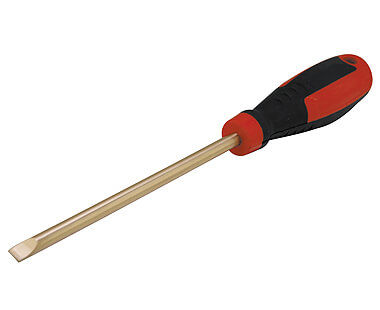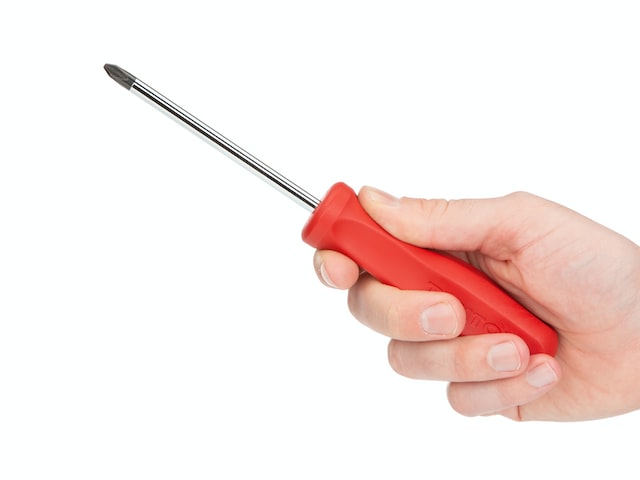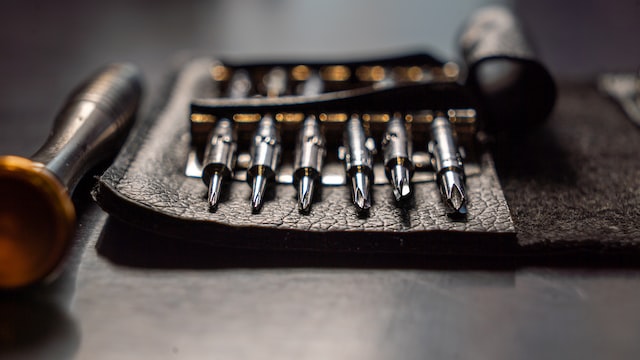Using a screwdriver is one of those tasks that most people have done at some point in their lives. So why do we need a discussion about it? Well, because there are so many different kinds of screwdrivers out there, it’s important to make sure you’re operating the right one for your project. You wouldn’t use your drill as a circular saw, would you? The same goes for screwdrivers! We’ve put together this quick guide to show the battle between flat screwdriver vs. Phillips. Read this properly so that next time you start working on something around the house or office, or wherever else, you’ll be able to do it with ease.
Pros And Cons Of Screwdriver (Flat)

Flat screwdrivers are used in a variety of situations, from installing light fixtures to tightening the screws on your glasses. This screwdriver is an essential tool for any toolbox. You can use them for different types of jobs.
🟦 Pros
A flat Screwdriver has many advantages, among which are enlisted below:
>>Durability
Flat screwdrivers are made of strong materials and built to last. It is often made of metal or some other hard material that can withstand wear and tear. This is because the flat screwdriver is used to drive in screws, which can be tough on tools if they’re not made properly. The metal used to make flat screwdrivers is also very resistant to rusting. Unlike wooden ones that will eventually decay over time in a moist environment like your workshop or garage.
>>Tolerance
You may have noticed that flat screwdrivers have a higher tolerance than their Phillips counterparts. This means that they are less likely to slip from their positions when you’re trying to loosen or tighten screws, making them more effective for use in many different kinds of applications.
This is because flat screwdrivers’ tolerance is lower than that of Phillips head drivers. And this means they’re more likely to stay put when working on multiple tasks and projects. This allows you greater accuracy and safety while working!
>>Affordability / Cost-effective
There are many advantages of buying a flat screwdriver. First, it was cheap. You can buy a good quality screwdriver for about $10-$15, which is less than the cost of some other tools. Second, the flat screwdriver can be used for many purposes, including small jobs and big jobs. Many people use their flat screwdrivers to take apart computers and other small electronic devices. However, it can also be used to remove or tighten screws on larger objects like furniture or appliances as well. Finally, because they’re so versatile and easy to use, there’s no need to buy different types of screwdrivers when all you really need is one!
>>Convenience
The flat screwdriver is easy to use and can be used in tight places where the head of a Phillips or Pozidrive screwdriver would not fit. The flat blade is small, lightweight, and easy to carry around with you in your toolbox or on your keychain. This makes it convenient for when you need them most!
>>Available in different sizes and designs
The flat screwdriver is available in different sizes and designs. This makes it a versatile tool that can be used for many applications. The most common sizes are 1/8″, 3/16″, and 1/4″. Flat screwdrivers are also available with ¼” tips for use in hard-to-reach areas or small parts.
As mentioned earlier, the flat head is designed to fit into tight spaces where other types of screwdrivers would not function properly or at all. This makes this type of screwdriver ideal for working on electronics like computers and phones. As well as stereos and appliances such as microwaves and refrigerators.
🟦 Cons
As mentioned, the flat screwdriver is one of the most basic tools in your arsenal. It’s also one of the most versatile tools in your toolbox, capable of working on both wood and metal. Flat Screwdrivers are used for everything from assembling furniture to building cabinets and installing plumbing fixtures. They’re an essential part of any DIYer’s tool kit, but their usefulness isn’t without its drawbacks.
In this section, we’ll explore some of those disadvantages so you can decide if a flat screwdriver is right for you!
>>Not compatible with all types of screw heads
Flat screwdrivers are not compatible with all types of screw heads. They are not compatible with Phillips and Pozidriv screw heads, which are more popular than flat head screws. While flat head screws have been around for a long time, they’re still used in some places.
>>Require a lot of pressure when tightening or loosening screws
Flat screwdrivers are designed for a specific purpose. They have flat heads which allow you to put pressure on the screw to tighten or loosen it. This requires you to apply a lot of force in the right direction and with the right amount of pressure. This is for them to work properly and not damage anything else around them.
>>Not suited for working in open spaces
While they can be used in open spaces, they are not as well suited to working in open spaces as other types of screwdrivers. This is because the flat head of a flat screwdriver has little traction on its surface. Making it harder to turn the screwdriver if your hands are slippery or wet. The flat head also presents less surface area than other types of heads. This means that you’re liable to slip off of your target more easily.
That said, if you need to work on something small like eyeglasses or watches, then a flat head will work better than any other type. This is because there isn’t much room for error with such small objects!
>>Can be a little tricky to use if you’re not an experienced user
A flat screwdriver is a useful tool, but it can be a little tricky to use if you’re not an experienced user. That’s because it requires precision, and sometimes even more so than a Phillips head or Torx driver. You need to be careful when using a flat screwdriver, especially if you don’t have much experience handling one. It’s easy to slip and damage the screw head if you don’t apply enough pressure or control how much force you put on the blade. You also need to make sure that you don’t drop the tool while working with it since it could cause serious injury if this happens in certain situations, like working with electricity.
Pros And Cons Of Phillips Screwdriver

The Phillips screw system is the most popular screw system on the planet. It’s been around for over 100 years, and it’s still going strong!
🟦 Pros
There are many reasons why Phillips screws have such staying power. In this section, we’ll explore some of those reasons, including how this type of screw works and why precision manufacturing makes it so popular with consumers.
>>Screw system
Phillips screw systems are popular because they are easy to use. They’re safe and simple to use, widely available, standardized, and have a large range of sizes and styles.
>>Safe and simple to use
Phillips screwdrivers are safe and simple to use. The Phillips head, which looks like a cross, is designed to go in at an angle and then turn in a circle. This prevents you from putting too much pressure on the screw or stripping it when you try to loosen it.
That makes them simple to use for DIY projects and other small household tasks. The design also keeps screws from turning or coming loose after they’ve been tightened down, which can happen with other screw types if they aren’t installed correctly or are over-tightened.
>>Wide range of styles and sizes
Phillips screws are available in a variety of styles, sizes, and materials. Its screw systems can be used in many different applications and industries. They have been around for over 100 years and continue to be an important part of many designs today.
>>Standardization and availability
Standardization and availability are two of the biggest advantages of Phillips screws. This means that there is a wide range of sizes available, from very small (1/8″ or 0.125″) to very large (3-1/2″ or 0.875″). Availability means that you can buy them in most hardware stores or order them online if your local store doesn’t stock them.
It’s easy to find the right size because each Phillips screw size has an international symbol stamped on it. Triangle with three lines inside for #0 through #9 (the smallest), and triangle with four lines inside for 1/4″, 3/8″, and ½.” This makes it simple to identify which tool you need!
🟦 Cons
If you’ve ever tried driving a Phillips screw into a piece of wood or metal, you know it can be frustrating. The tip of the screwdriver wants to pivot and turn in every direction except for one. So before turning the screw, let’s reveal the disadvantages of one of the most prominent screwdrivers: Phillips!
>>Can only be turned in one direction
This is an important point to remember when working with Phillips screwdrivers. The Phillips screwdriver can only be turned in one direction. This means that if you try to turn the screwdriver back and forth, you could strip out the head of the screw or damage your tool. If you encounter a situation where you need to loosen or tighten a Phillips-head screw, it’s best to use another tool for that job and then return back to using your Phillips driver for whatever else needs doing.
>>”Cam out”
The cam-out problem can occur when you’re trying to loosen a tight screw. The screwdriver slips out of the head, which makes it difficult to continue turning and loosening the screw. This is especially true if you’re using a low-quality Phillips screwdriver that doesn’t grip as well as it should or if you have limited hand strength.
The cam-out problem can also occur when using a Phillips head screwdriver on the wrong type of screws! For example, many woodworkers will use their Phillips head wood screws in metal projects without knowing that they don’t have enough torque and grip to hold onto most types of metal surfaces. This leads these users into trouble when they try to remove their fasteners after installation because they didn’t use enough force or know how much torque was necessary for them in the first place!
>>Can strip the head of the screw and damage it
You can also strip the head of the screw, which will make it impossible to remove. When you try to turn it in the wrong direction, you may damage both the head of the screw and its surrounding area. This can be frustrating because it makes your project take longer than necessary.
Differentiating Screwdriver From Phillips

Screwdriver and Phillips are two types of screwdrivers used by home repair and handyman professionals. They are different in the way they work, but they both serve the same purpose: to drive or remove screws.
🟦 Tip
Screwdrivers have a flat tip with one rounded end, while Phillips screwdrivers have a cross-shaped tip that fits into a cross-shaped slot on the head of a Phillips screw.
🟦 Sides
While a Phillips driver has six or more sides, a regular flathead driver has only one or two sides. The sixth side of the Phillips allows for better grip when turning because it increases friction between the driver and the screw head. This makes it easier for you to drive screws without damaging them or stripping them out (which happens when you turn too hard).
🟦 Maneuver
Flathead screws are not self-tapping; they require a drill bit to create the hole in which they’re installed. On the other hand, Phillips head screws can be easily driven into place by hand with no additional equipment needed. Because of this characteristic, Phillips head screws are often preferred for outdoor projects where you want to minimize your need for power tools or extra equipment. And because they are self-tapping, they allow you to get more done faster!
Which Screwdriver Should You Use?
The answer to this question depends on what you’re going to be using the screwdriver for. If you’re planning on opening or repairing electronics, a flat head screwdriver will serve you best as it’s better at prying things apart and getting into tight spaces than a Phillips head driver. However, if you’re trying to put together furniture or other home goods (or take them apart), then a Phillips head driver is definitely your best bet.
When choosing your next screwdriver, keep in mind that they come in different sizes and shapes with varying numbers of points on the end of each tip. You can buy some pretty specific ones with different kinds of tips. But all we really need are some basic ones, so we know how they work before branching out into anything fancy!
Frequently Asked Questions
🟥 What are some of the best ways to loosen rusty screws?
Lubrication is one of the best ways to loosen rust. You can use kerosene or any other oil in a spray bottle to lubricate rusty screws. Make sure that you spray enough liquid for the screwdriver to reach all sides of the screw as it turns.
Another way to remove rust from screws is by sanding them down until they are smooth and shiny again. Using your hands or sandpaper will work just fine if you’re patient enough! If your screwdriver has an impact head at its tip, this can be helpful, too, because it allows you to leverage on small spaces (like between two tightly spaced wires).
🟥 Is the driver stronger than the screw?
The answer is no. Phillips screwdrivers are made to be strong enough to turn the screws in your car or computer, but they’re not specifically designed to withstand torque like you would find in a ratchet or breaker bar.
Because of this, you can use a flathead screwdriver on a Phillips’s head, and it will work fine for light-duty jobs (like removing screws from an outlet cover). However, if you try to use the same method on heavier hardware (like door hinges), then there’s the chance that you could strip out the slot in the head and damage your screwdriver blade. If you want more power behind your tool choice, switch over to using an impact driver instead!
🟥 Are flathead screwdrivers always slotted?
Flathead screwdrivers are not always slotted. In fact, most flathead screwdrivers are non-slotted. Phillips head screws have a cross-shaped slot, which is used to turn them with a Phillips head screwdriver. Flathead screws come in all shapes and sizes, but they do not require this type of head shape; therefore, slotted drivers are not needed for them.
🟥 Can I use my drill motor as a screwdriver?
A drill motor can be used as a screwdriver, but it will not work as well as a dedicated flathead or Phillips head driver. To understand why this is so, you need to know how the rotational speed of a drill motor differs from its rotational speed when used for drilling.
The average electric drill motor has an RPM range of 0-1,000. When at full power spinning in reverse (with no bit attached), it will spin at around 740 RPMs (Revolutions Per Minute). In forward motion with a standard 1/4″ bit attached, the same drill motor may have an RPM range between 300 and 700, depending on your specific model and the type of bit that you have in place.
🟥 How important is it to keep your screwdrivers clean and sharp?
When you’re working on a project, it’s important to keep your screwdrivers clean and sharp. If your screwdriver is dirty or rusty, the head won’t fit into the slot of a screw properly. This will make it hard for you to get them tight enough to secure whatever it is that you’re trying to hold together.
Final Words
So there you have it! In short, flat-head screwdrivers are best for removing screws with sunken heads or those that aren’t too large. Phillips-head screwdrivers, on the other hand, are better for driving and removing screws with small, raised heads.
Of the two, the flat driver has the most benefit. It provides a steadier application of pressure and allows for better access to all of a screw’s length. But that doesn’t necessarily mean that you should ditch your Phillips’s head. Who knows when you’ll need to deal with those pesky Phillips heads? If your project calls for the utmost precision, go with a flat head. But if not, a Phillips head will probably do just fine.
If you’re an electrician and looking for the best set of screwdrivers, click here!


